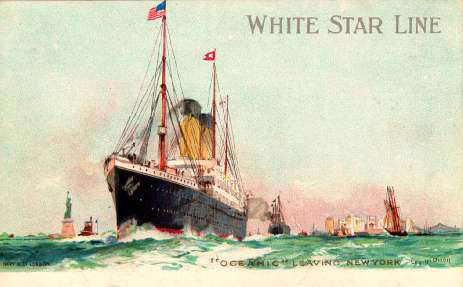
The Oceanic's Cargo
The Oceanic's Cargo
The Oceanic's Gold CargoNOTE: We have since determined through Bank of France records that the Oceanic's cargo did indeed arrive. We then focused on the $3 million 1 1/2 % 30 day loan as a part of the financing of Russia's January 22, 1909 bond. See my book The Tsar's Treasure with the more current research. CLOSING OF MAILS AT NEW YORK European Mails. Wednesday, Jan 13 - ... Europe, Africa, West Asia and East Indies, via Plymouth and Cherbourg, at 6:30 AM, str Oceanic. New York Herald, Jan. 13, 09; 14:1 White Star Line's Royal Mail Ship Oceanic departed the White Star Line pier in New York at 10 a.m., January 13, 1909, with ports of call, eastbound, at Plymouth and Cherbourg, and westbound, Cherbourg - Southampton - New York. Our deduced cargo for the Oceanic conflicts with certain newspaper accounts purportedly describing her cargo. Several newspaper reports and U. S. Customs' accounts suggest that the Oceanic carried the January 11th and 12th engagements, although the bar/coin composition of her gold shipment varies depending on the particular report, from $500,000 bars/$3,000,000 coin, or $1,000,000 bars/$2,500,000 coin, or $2,500,000 bars/$1,000,000 coin, to $3,500,000 bars/ $0 coin, all for total shipments aboard the Oceanic of $3,500,000 combined bars and coin. We have deduced that the Oceanic did not carry the January 12, 1909, $3,000,000 American Gold Eagle engagement and that this engagement remained to be shipped aboard another vessel after the Oceanic's departure: several newspaper articles appeared on January 14th and 15th and described gold, including the $3 million engagement, which remained to be shipped from New York AFTER the Oceanic's departure (remember, after the January 12, 1909, engagement, the next engagement to Europe occurred on March 9, 1909), the Export/Import data identifies a loss of the $3 million engagement, and, as a result, this consignment is presumed to be aboard the Republic - the only marine casualty occurring within the shipment time parameters. See also: Loading Aboard The Republic. This theory was developed by a thorough analysis of financial activity of the New York gold market, export/import data, and a discussion of gold shipment procedures. We have attempted to document the unlikely shipment aboard the Oceanic of the January 12th, $3,000,000 American Gold Eagle engagement. According to another newspaper account, National City Bank had not even placed their request for their $2,000,000 coin portion of the January 12, 1909, engagement with the Sub Treasury as of January 14!! [emphasis supplied] and, therefore, according to that account, this engagement could NOT have been aboard the Oceanic when she sailed from New York on January 13, 1909. ARRIVED OUT. Ss Oceanic, at Cherbourg from New York. N. Y. Sun, January 21, 09, 11:5 The Oceanic arrived at Cherbourg on January 20th. UN CHARGEMENT D'OR Cherbourg, 21 Janvier. Le transatlantique allemand Océanie, faisant escale à Cherbourg, a débarqué vingt barils d'or, renfermant une somme totale de 50 millions. Le Petit Journal, Derniéres Nouvel, 22 Janvier 1909, 1:2 [Translation] A CONSIGNMENT OF GOLD Cherbourg, January 21.
The German transatlantic liner Océanie, stopping at Cherbourg, unloaded twenty barrels of gold, for a total sum of 50 million. Le Petit Journal, Latest News, January 22, 09, 1:2 Upon further investigation, a German liner Océanie, or any vessel, steam or sail, named Océanie, is nonexistent under any nation's registry in Lloyd's Register of British and Foreign Shipping, 1908 and 1909 editions, a comprehensive listing of all commercial shipping vessels. Additionally, during 1909, all gold imported into France by ship originated from only two countries, Britain and the United States; gold imported by France from Germany was transported across land borders.1 If we understand that the French word for British is "angleterre," we can presume that a typographical error exists in Le Petit Journal's report and that the report concerns the British liner Oceanic. ...When bars are shipped abroad, who stands the expense, the exporting bank or the Treasury? Why is gold coin not preferable? Harper's Weekly, February 6, 09, 30:3 To prevent abrasion (barrels rolled - not an issue for bars when packed with sawdust), gold coins were shipped in boxes! See Article Uncle Sam's Coin Experts Busy and More Details. The Oceanic unloaded twenty barrels of gold, each barrel worth approximately $48,000, for a total shipment of approximately $960,000. 960,000 - "1909" dollars computes to 4,914,214 - "1909" francs,2 or approximately 5 million francs, not the 50 million that the Le Petit Journal reported - apparently another typographical error. This report compares favorably to our postulated cargo of the Oceanic and is in accord with the French import data; the Oceanic carried the gold bar component of the January 8th engagement and the January 11th gold bar engagement, for a total gold bar (packed in barrels) shipment of $920,000, specifically $929,864.
The Globe and Commercial Advertiser, January 15, 1909, 13:3 The remaining $1,500,000 of the January 8th engagement consisted of Philadelphia Mint bars and was shipped aboard some other as yet unidentified vessel (most likely the American Liner Philadelphia which departed New York at 10 a.m. on Janmuary 16, 1909) which arrived in France before the end of January (as reflected in the French import data. The Philadelphia arrived at Cherbourg on January 23, 1909.), leaving the $3,000,000 American Gold Eagle engagement to be shipped - the conclusion of this research report, Captain Bayerle's Third TheoryTM - aboard the Republic. |
|
FOOTNOTES1Tableau Général Du Commerce Et De La Navigation Année 1909, (ENLARGED). 2Dollars/20.507 = Troy Ounces. Troy Ounces/32.15074 = Kg. Kilogram value in francs determined by bar import value from Documents Statistiques Reunis par L'Administration Des Douanes sur Le Commerce De La France, 1909, 1910, et 1911, mois de janvier, 1909. |
|

